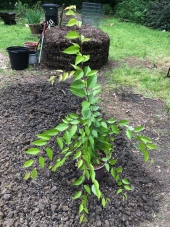To add to Dan's info regarding attracting Cardinals to your land, they are ground feeders and hang out and nest in dense shrubbery. I have a row of old and overgrown azalea bushes planted along the pine line, and I always see them in those azaleas. They love sunflower seeds. And they are VERY aware of your blueberry bushes :-) I have about 10 blueberry plants that are still in pots as I am yet to clear the patch where they will go. Last summer, to protect them from deer browse, I moved blueberry pots into the fenced veggie area, lining them up against the fence. They were within 10-15 fit of the tomato plants. At any given time, I had 4 to 6 Cardinals trying to get the berries. Cardinals and Robins seemed to spy blueberries VERY quickly, no matter where I moved them. The thing is, pretty much all birds are territorial, and any time you see more than one pair of the same species in close proximity, an "argument" ensues, and males start getting into each other's way and chasing one another rather than eating blueberries.. in the end, it's the Robin that got the berries lol. But both are larger birds able to handle larger insects. So if you want to attract birds to a specific area and not bother with having to maintain/stock a bird feeder, plant a couple of blueberries for them, one early season, one late.. I find that, if undisturbed, birds tend to hop around and investigate immediate surroundings...
And I second, I had no horn worm issue in this patch at all this summer (and horn worms are a big pest here too). For full disclosure, I did find two tomatoes that were pecked into, but it happened only once, so I will write it off as an accident :-) One of the gardening books said that when birds peck into tomatoes they are seeking water/moisture, not the tomato itself. So having a source of water for them/birdbath should eliminate this problem. I wonder if this is also the case with other juicy edibles, such as peaches, for example.
Ian, I have not heard about the geraniums.. if you continue the experiment, let us know the results.
I have not seen robber flies around. It doesn't mean they are not around of course.. I will read up more about them. From initial research on wiki, it states that they prefer dry climates, which ours is not. But hey, if there is lots of food around, maybe I could coax them in!





